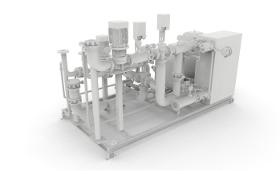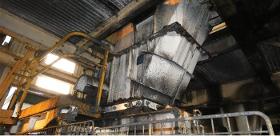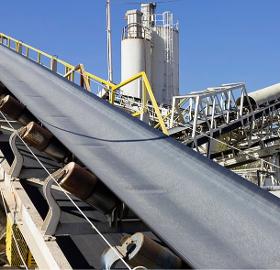DE SMET ENGINEERS & CONTRACTORS - From Basic Engineering to Full Turnkey Projects
Belgium
Service Provider


DE SMET ENGINEERS & CONTRACTORS
Belgium
DSEC's commitment on the construction of Bioethanol plants is based on a very specialized technical knowledge of the Ethanol production processes; in this article you will find a more detailed understanding about the process of Cellulosic biomass. Cellulosic biomass is the structural portion of plants and includes agricultural (e.g. Corn Stover, which is the entire above-ground portion of the corn plant, excluding the grain) and forestry (e.g. sawdust) residues, major fractions of municipal solid waste (waste paper and yard waste), and herbaceous (e.g. switch grass) and woody (e.g. poplar) crops grown as energy resources. Although distinctive in outward appearance, these materials all comprise about 40-50 % cellulose and 20-30 % hemicelluloses, with lesser amounts of lignin and other compounds, such as sugars, oils and minerals. Cellulose is a polymer of cellobiose (glucose-glucose) sugar molecules that are physically linked together in a crystalline structure to provide structural support for plants. Within these micro fibrils cellulose is found in two forms, namely amorphous and crystalline. The crystalline form of cellulose is particularly difficult to degrade and typically makes up the core of a lignocellulosic microfibril.
Request for a quote
DE SMET ENGINEERS & CONTRACTORS
Belgium
DSEC's commitment on the construction of Bioethanol plants is based on a very specialized technical knowledge of the Ethanol production processes; in this article you will find a more detailed understanding about the Upstream process. In Europe and the US, the existing traditional 1" generation bioethanol plants typically process cereals (maize/corn, wheat, rye, ...) and other starch or sugar containing raw materials (e.g. sugar beet). The raw material initially undergoes crushing (milling for cereals) to reduce the particle size distribution to such a degree that the enzymes enter in contact with the starch molecules in the subsequent steps. During liquefaction with alpha-amylase, starch is dismantled into low molecular sugar units, the so-called dextrines. In the next process step, saccharification, these dextrines are further dismantled into fermentable sugars by means of gluco-amylase. In the fermentation process, these fermentable sugars are partly aerobically transformed, but mainly anaerobically by Saccharomyces cerevisiae (yeast) into biomass and ethanol; sugar containing raw material as e.g. sugar cane can be directly fed into fermentation after crushing. Upstream process groups: - Storage - Cleaning - Milling / Crushing - Mashing - Liquefaction - Saccharification - Fermentation (batch or continuous)
Request for a quote
DE SMET ENGINEERS & CONTRACTORS
Belgium
DSEC's commitment on the construction of Bioethanol plants is based on a very specialized technical knowledge of the Ethanol production processes; in this article you will find a more detailed understanding about the Downstream Process. The alcohol in the fermented mash is then concentrated by means of distillation and rectification, before the required water content of ethanol is regulated in the dewatering process. The accrued residues from distillation, the so-called stillage, is first evaporated and then dried to animal feed, the so-called DDGS. However, the production (drying) of DDGS requires a considerable amount of primary energy (e.g. fuel oil or natural gas); therefore, if feedlots are nearby, animal feed will be sold in wet condition, so called WDGS. For sugar cane and molasses the residue, so called vinasses, was returned to the fields as fertilizer- due to sustainability reasons and change in legislation, spraying of vinasses on the fields is mostly forbidden in the meantime. In the past, direct combustion of DDGS turned out to be unfeasible because of procedural difficulties and lacking efficiency (due to the high water content of the stillage). The realisation of a biogas plant could not be achieved in large scale so far because of the enormous quantities of stillage and their high organic stress. Combination of ethanol production with biogas respectively, biomass burning results in different biorefinery concepts or so called next generation technology.
Request for a quote
DE SMET ENGINEERS & CONTRACTORS
Belgium
Thanks to its deep knowledge of all unitary operations related to edible oil, sugar and sugar fermentation processes, De Smet Engineers & Contractors is the ideal partner for assisting investors in developing and implementing biochemical production plants and bio-commodities production facilities. DSEC has already successfully built for international key players a betain and several inulin plants based on their proprietary knowhow. Moreover, DSEC’s experience in implementing cogeneration units built along with facilities for the production of fermentable grade sugar (derived from sugar beet, cane and grains) allows the company to fine-tune the overall process set-up in order to achieve ideal conditions with regard to material and energy flows. Notable examples of bio-based chemicals include non food starch, cellulose fibers and cellulose derivates, tall oils, fatty acids and fermentation products such as ethanol and citric acid for which. DSEC is fully qualified to provide the facility that will efficiently generate the required feedstock on an industrial scale. From a technical point of view, almost all industrial materials respectively their building blocks made from fossil resources can be substituted by their bio-based counterparts: • C2 building blocks: ethanol, acetic acid • C3 building blocks: lactic acid, 3-hydroxypropanoic acid, glycerol • C4 building blocks: fumaric acid, succinic acid, butyric acid, 1-butanol • C5 building blocks: itaconic acid, furfural • C6 building blocks: citric acid, glucaric acid, 5-HMF, adipic acid
Request for a quote
DE SMET ENGINEERS & CONTRACTORS
Belgium
Through its heritage from Mr. Jean-Albert De Smet, inventor of the De Smet continuous counter-current solvent extractor, De Smet Engineers & Contractors has continued to work closely with the edible oil production sector, offering the integration of all processing units and related auxiliaries from seed storage to refined oil packaging. DSEC’s understanding of vegetable oil techniques provides a unique background for the implementation of a comprehensive project, being with its definition, its construction or its operation. Edible Oils Plants construction requires a deep specialization that De Smet Engineers & Contractors processes over years of experience in projects implementation around the world and a very capable team of engineers that masters every detail of Edible Oil Production as well as all the technical capabilities required. DSEC´s Contracting Services offers the client a wide variety of contractual setups from Conceptual Engineering, Front End Engineering Design (FEED) to Full Turnkey (EPC) or EPCM to adapt to every client needs.
Request for a quote
DE SMET ENGINEERS & CONTRACTORS
Belgium
De Smet Engineers & Contractors has been involved in all steps of the production of vegetable oils from oilseeds crushing for the construction of Edible Oils Plants; in this article you will find a more detailed understanding about the process of vegetable oil extraction: First step: Preparation of the oil containing material prior to solvent extraction Cleaning and Drying The plant feedstock must be cleaned so that foreign matters are removed. This applies particularly to sand/silicate and iron which may damage the preparation plant equipment. For some seeds or for some processes the incoming material moisture must be controlled and adjusted for better efficiency of subsequent operations. Mechanical preparation Most of raw materials needs to broken to reduce the particle size to ensure proper cooking and flaking. They are then heated in cooking / conditioning equipment and their moisture further controlled in addition to be softened before the next mechanical operations. After cooking, heated grits are flaked so that the oil cells are broken and the oil more readily available for further solvent extraction or mechanical pressing. Pressing Oilseeds containing above 20 to 25% (rapeseed, sunflower seeds, cottonseeds...) are generally pressed mechanically in order to extract most or part of the oil available in the feedstock. This operation is done through full pressing for maximum oil recovery leaving up to 5 to 10% in the final cake which is marketed as such or through a low pressure pre-pressing operation producing a cake with higher residual oil content which is then recovered in the solvent extraction plant. Dehulling Oil extraction plants produce a solid finished product in addition to the extracted oil; this product (cake or meal) is normally used as an important component for animal feed recipes. Depending on the meal destination, its protein content often needs to be increased and its fibre content minimized. Such characteristics are generally achieved through decortication or dehulling operations that separate the outer part of the feedstock before extracting the oil. Second step: Solvent extraction of the material suitably prepared Extraction In the solvent extractor, solids (Flakes from the flaking machines or cakes from the pre-presses) are conveyed through the equipment while a mixture of hexane and oil (miscella) is sprayed counter-current. The extractor produces therefore deoiled solids containing solvent and miscella. Desolventization Deoiled solids coming out of the extractor are conveyed to a dedicated equipment that completely removes the remaining solvent while preserving the meal quality: the desolventizer. This apparatus is usually combined with additional sections for drying and cooling the meal to the required storage and market parameters. Miscella distillation Solvent contained in the miscella is completely removed under vacuum and optimum temperature for preserving oil quality. The solvent from the distillation as well as the one removed at meal desolventization stage are then recycled to the extractor. Solvent recovery Since the air entering the process together with material fed to the extractor is laden with solvent when it is removed from the plant it first pass through a specially designed absorption column to limit emission to an acceptable level. Meal treatment The extracted meal is often subject for further treatment, including grinding to obtain the required granulometry or pelletizing to reduce its volume during transport.
Request for a quote
DE SMET ENGINEERS & CONTRACTORS
Belgium
Edible Oil production is able to process different qualities of products depending on the needs of the market. For some cases the clients may only need the process of Vegetable Oil Extraction, but in order to have the premium quality oil, the Vegetable Oil Refining process will be required. De Smet Engineers & Contractors can assist your company to decide the best process requirements as well as the Contractual Setup that adapts better for every client's case. Following are the main steps of an Edible Oil Refining process: Degumming Degumming reduces the phosphatides content in some crude oils (soybean, sunflower, rapeseed etc) Neutralizing The free acids contain in oil can be either alkali neutralize. Most oils can be "physically" neutralize in the deodoriser render this alkali treatment unnecessary Bleaching During this operation most colouring pigments are removed by absorption bleaching earth. Deodorizing Odour and taste are removed under special condition (high temperature and sparge steam) Winterizing Some oils like sunflower will present an un-pleasant turbidity at low temperature. This can be removed by eliminating components like waxes which solidify at low temperature.
Request for a quote
DE SMET ENGINEERS & CONTRACTORS
Belgium
DSEC has been active in biodiesel production EPC as an alternative for the production of biofuels. Our company favors biodiesel production because it's a biodegradable, non-toxic, produced from renewable resources (vegetable oils, recycled or fatty frying oils animal) and that contains no petroleum product but which can be used to replace petroleum diesel in diesel engines. It can be used pure 100% (B100) as fuel replacement but it is used more often mixed with petrodiesel in concentrations of 2% (B2), 5% (B5) and 10% (B10). Unlike some other biofuels, it requires no modification or adjustment, either at the level of the engine, components of the system of power or fuel storage system. De Smet Engineers & Contractors was able to extend its activities from Edible Oils & Fats to the biodiesel plants construction as a logical evolution for Vegetable Oils processing, offering the same quality and dedication with a range of services starting with Engineering & technical assistance to full turnkey projects (EPC) or EPCM commitments.
Request for a quote
DE SMET ENGINEERS & CONTRACTORS
Belgium
Biodiesel production consists of the following units: Transesterification Methylester / glycerin separation Final methylester / glycerin centrifugation Methylester purification - flash of methanol Raw glycerin purification - soap splitting Raw glycerin purification - methanol separation Methanol rectification Vents condensation
Request for a quote
DE SMET ENGINEERS & CONTRACTORS
Belgium
DSEC's commitment on the construction of Biodiesel plants is based on a very specialized technical knowledge of the Biofuels production processes; in this article you will find a more detailed understanding about the process of Methylester and Glycerin Production. Transesterification The transesterification reaction is accomplished in continuous, using reactors in series operating under mild conditions. The raw material is dried in flash chamber and then is continuously fed to the first reaction loop. Catalyst is continuously dosed. The Methanol is fed to the reaction unit in a proper excess. The separate glycerin is rich in soap and is directly sent to the glycerin treatment. The light phase outgoing from the head of the first reaction loop is transferred to the second reaction loop after the addition of fresh methanol and catalyst. The light phase coming from the top of the second reactor is transferred to the third reactor with addition of methanol and catalyst. The third transesterification reactor is a stirred vessel. The glycerin separated at the bottom of the second separator, relatively rich in methanol and catalyst, is recycled to the transesterification unit. The reaction mixture leaving from the third reactor containing the product (Methylester), the excess of methanol and the glycerin (reaction by-product) and a limited amount of soaps is sent to the Methylester purification section.
Request for a quoteService Provider
Watson & Crick Hill - Building J - Rue Granbonpré 11 Box 8
1435 Mont-Saint-Guibert - Belgium
europages also recommends
A selection of companies related to the activity:
A selection of products that might interest you

NC MANUFACTURING AND ENGINEERING
Turkey
We successfully carry out the mechanical processes of the diesel-cogeneration systems all around the globe. In field applications, we work with our highly experienced teams. In mechanical assembly and manufacture works, all kinds of steel construction, duct, piping, equipment and machinery are assembled and manufactured.
Request for a quote
TOMECH SOLUTIONS
Romania
Screens play a crucial role in material handling and sorting processes by separating particles based on size, shape, and composition. They are commonly used in industries such as mining, construction, recycling, and agriculture to classify and sort bulk materials efficiently. Screens consist of a surface with apertures or perforations of varying sizes, through which material passes. As the material moves across the screen surface, particles smaller than the aperture size fall through, while larger particles are retained. Screens can be vibratory or stationary, depending on the application and required throughput. We specialize in screen design services, offering customized solutions to optimize screening efficiency, throughput, and product quality. Our expertise encompasses the design, selection of screen media, and configuration of screening equipment to meet the specific needs of our clients and enhance the performance of their material handling and sorting operations.
Request for a quote
TOMECH SOLUTIONS
Romania
Hoppers and transfer chutes are essential components of material handling systems, facilitating the smooth movement and transition of bulk materials within industrial processes. We specialize in hopper and chute design services, offering tailored solutions to optimize material flow, minimize downtime, and improve overall system performance. Our expertise encompasses the design, analysis, and optimization of hoppers and transfer chutes to meet the specific requirements of our clients and enhance the efficiency of their material handling operations.
Request for a quote
TOMECH SOLUTIONS
Romania
Conveyors are mechanical devices used to transport materials from one place to another within a facility or between different locations. They are integral to numerous industries, including manufacturing, logistics, and transportation. Types of conveyors include: belt conveyors, roller conveyors, screw conveyors, chain conveyors, gravity conveyors, bucket conveyors. We specialize in conveyor design services, tailoring solutions to meet the unique needs of our clients. Our expertise covers the design, optimization, and implementation of conveyor systems to enhance efficiency, productivity, and safety in diverse industrial settings.
Request for a quoteRequest for quotes
Create one request and get multiple quotes form verified suppliers.
- Only relevant suppliers
- Data privacy compliant
- 100% free


